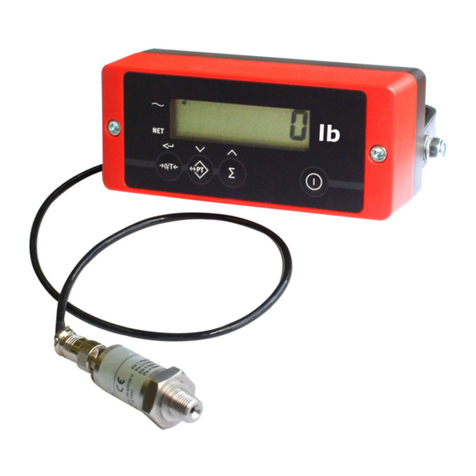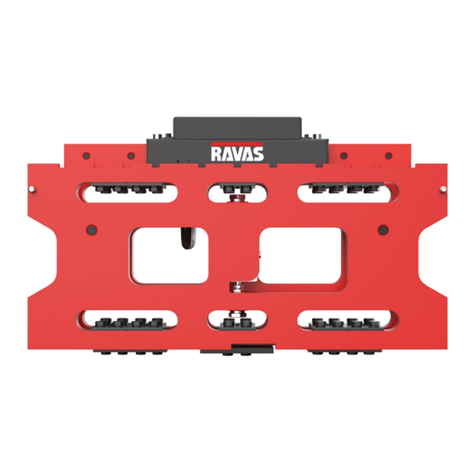Ravas RCS Hy-Q-52 User manual

INSTALLATION MANUAL
–
RCS
Hy-Q-52 1
INSTALLATION MANUAL
Rev. 20210614
Printing/Typographical errors and model changes reserved.
RCS Hy-Q-52

INSTALLATION MANUAL
–
RCS
Hy-Q-52 2
PLEASE RETAIN THESE ASSEMBLY INSTRUCTIONS FOR FUTURE REFERENCE
If you have any queries concerning the duration and terms of the guarantee, please contact your supplier.
We would also refer you to our General Sale and Supply Conditions, which are available on request.
The manufacturer accepts no liability for any damage or injury caused by failure to follow these instructions,
or from negligent operation or assembly, even if this is not expressly stated in this instruction manual.
In light of our policy of continuous improvement, it is possible that details of the product may dier from
those described in this manual. For this reason, these instructions should only be treated as guidelines for
the installation of the relevant product. This manual has been compiled with all due care, but the manu-
facturer cannot be held responsible for any consequences of errors. All rights are reserved and no part of
this manual may be reproduced in any way.
We would like to inform you about the fact that this RAVAS product is 100% recyclable on the basis that the
parts are processed and disposed o in the right manner.
More information can be found on our website: www.ravas.com

INSTALLATION MANUAL
–
RCS
Hy-Q-52 3
Table of Contents
1. Introduction 4
2. Warning & Safety measures 4
3. Before the installation 5
3.1 Capacity of the forklift truck 5
3.2 Maximum pressure in the hydraulic system 5
3.3 Battery voltage of the forklift truck 5
3.4 Making the hydraulic system pressure free 5
3.5 The condition of mechanical components of the forklift truck 6
4. Installation 7
4.1 Hydraulics: Installing the T-piece 7
4.2 Hydraulics: Mounting the oil pressure sensor 10
4.3 Mechanics: Installing the position switch holder 11
4.3.a Mechanics: placing stickers to mark reference height 13
4.4 Mechanics: Installing the indicator 14
4.5 Electronics: Mounting the cables 15
4.6 Electronics: Wiring diagrams 16
4.7 Electronics: Connecting the power supply cable 18
4.8 Remove any air from the hydraulic system 18
5. Calibration 19
5.1 Preparing for calibration 19
5.2 Bringing the forklift truck to operating temperature 20
5.3 Operating key functions of indicator 21
5.4 Display functions 21
5.5 Start calibration procedure: rst go into the service menu 22
5.6 Set the scale capacity 23
5.7 Change unit label 24
5.8 Set the overload value 24
5.9 Setting the service date 25
5.10 Go into the calibration menu and perform a zero calibration 26
5.11 Execute weight calibration: slow & fast speed 29
5.12 Set zero 30
5.13 Delete a calibration point 30
5.14 Level switch 31
5.14.1 Activate level switch 31
5.14.2 Calibrate level switch 32
6. Parameter settings 33
6.1 Remarks 33
6.2 Parameter settings 34
7. RDC - data transfer 37

INSTALLATION MANUAL
–
RCS
Hy-Q-52 4
1. Introduction
2. Warning & Safety measures
When installing the RCS HY-Q-52, please carefully observe
the instructions and guidelines contained in this manual.
Always perform each step in sequence. If any of the
instructions are not clear, please contact RAVAS.
This manual describes the installation of the RCS Hy-Q-52. Read this manual carefully.
The installer must be informed of the contents of this manual. Follow the contents of the
manual precisely. Always do things in the correct order. This manual should be kept in a dry
and safe place. In case of damage or loss the user may request a new copy of the manual
from RAVAS.
• The installation of the RCS Hy-Q-52 should only be performed by an acknowledged
electro and hydraulic technical installer.
• Possible failures to the equipment must be communicated to your installer.
• The equipment should be checked annually by your installer.
• Always follow the safety measures concerning the forklift - or stacker truck accurately.
Should you have any further questions after reading this manual then you can contact us at:
RAVAS Europe B.V. Phone: +31 (0)418-515220
Toepadweg 7 Fax: +31 (0)418-515320
Postbus 2023 Internet: www.ravas.com
Nederland Changes reserved
READ
CAREFULLY
!

INSTALLATION MANUAL
–
RCS
Hy-Q-52 5
3. Before the installation
3.1 Capacity of the forklift truck
The RCS Hy-Q-52 can be installed on forklift trucks with a capacity of maximum 99 ton.
Before you start the installation, check the following points on the forklift truck:
3.2 Maximum pressure in the hydraulic system
The RCS Hy-Q-52 will operate optimally at an oil pressure up to 350 bar.
3.3 Battery voltage of the forklift truck
The most common voltages for forklift trucks are 12, 24, 48 and 80 VDC. The RCS Hy-Q-52
operates on 12 Vdc and always has a DC-DC power converter built in, which allows 9-100 V
DC input.
3.4 Making the hydraulic system pressure free
Before installation of the RCS Hy-Q-52 the hydraulic system of the forklift truck must be
pressure free. There are two ways to do this:
Option 1: Place the forks on the ground in their lowest position and make the hydraulic system
pressure free, by tilting the mast forwards. Be sure the chain is slack!
Option 2: Lift the forks and position them on top of a supporting surface. Make the hydraulic
system pressure free, by lowering the lifting cylinder into its lowest position. Be sure
the chain is slack!

INSTALLATION MANUAL
–
RCS
Hy-Q-52 6
3.5 The condition of mechanical components of the forklift truck
Find a suitable position for the indicator:
After installation of the RCS Hy-Q-52 system on the forklift truck, the weighing system is part
of the truck. In particular the mechanical parts of the forklift truck, such as the mast, mast roles
and bearings, will inuence the accuracy of the weightings. For this reason it is important that
these components are in good condition:
• no local wear in the mast of the forklift truck
• clean the system
• good lubrication of the mast and chains
• regular maintenance so that the condition of the system is constant
• when lifting and lowering the forks no whistling and cracking sounds from the mast
90°
M1
OK
IP65
min -10°C
15°F
00
max 40°C
105°F

INSTALLATION MANUAL
–
RCS
Hy-Q-52 7
We recommend that the installation of the sensor in the hydraulic system of the forklift is
performed by an authorized lift truck dealer.
• Ensure that there is no pressure on the main cylinder line.
• The sensor is mounted with a T-piece in the high-pressure hose, between the valves and
the main lifting cylinder.
• The connection on the sensor is G¼” BSP male.
• Protect the cable from moving, sharp or warm parts with the supplied protective cover.
• Mount the T-piece so that the sensor and the cable connection are pointing downwards.
This will prevent air getting into the sensor.
Choose a place where you can mount the sensor:
• Mount the sensor in the pressure hose that steers the main lifting cylinder. In most cases
there is one cylinder which moves the carriage plate. The sensor is mounted as close to
the cylinder as possible.
• If the pressure hose splits to multiple cylinders, the sensor has to be mounted before the
split.
• Do not mount the sensor too close to the engine. Large dierences in temperature can
inuence the accuracy of the system.
• If the truck is used intensively, a piece of pipe or hose of ± 50 cm can be mounted
between the sensor and the T-piece. The sensor is sensitive to temperature dierences.
If the moving oil becomes warm, the standing oil in this pipe or hose will remain cool and
the sensor will not be eected by temperature dierences.
• Place the sensor close to the cylinder. There is often more room there and it is easier to
reach.
• Choose, if possible, a place to mount the sensor where there are the least steering and
safety valves between the sensor and the cylinder.
4. Installation
4.1 Hydraulics: Installing the T-piece
OK
air can escape
WRONG
air gets trapped

INSTALLATION MANUAL
–
RCS
Hy-Q-52 8
Type A: 1 central cylinder
S19
1. 2.
Mount the T-piece into the
delivery line of the truck
near the cylinder for the
diversion of the pressure to
the RCS Hy-Q-52.

INSTALLATION MANUAL
–
RCS
Hy-Q-52 9
Type B: 2 cylinders on both sides
S19
1.
2.
Mount the T-piece into the
delivery line of the truck
near the cylinder for the
diversion of the pressure to
the RCS Hy-Q-52.

INSTALLATION MANUAL
–
RCS
Hy-Q-52 10
S19
2.
1.
4.2 Hydraulics: Mounting the oil pressure sensor
The thread on the sensor
is G 1/4“ BSP male.
Other manuals for RCS Hy-Q-52
1
Table of contents
Other Ravas Scale manuals




















